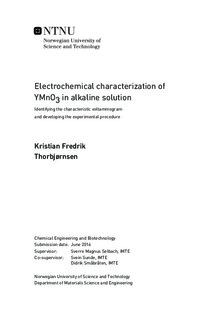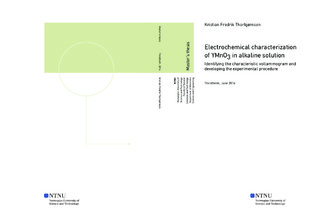| dc.description.abstract | Electrochemical intercalation of oxygen into oxide structures has been studied ever since it was first observed in 1990. A recent paper investigated using electrochemical intercalation of oxygen into vacancies in LaMnO3 for charge storage and pseudocapacitive applications. It was found that oxygen was inserted into the structure via a redox reaction. The findings offered a new paradigm for electrochemical charge storage. Hexagonal manganites have attracted a lot of attention the past years due to their multiferrioc properties and tailorable defect-chemistry. The hexagonal manganite YMnO3 has a significant potential for electrochemical storage of oxygen due to the possibility for incorporation of highly mobile interstitial oxygen anions into the lattice. The combination of oxygen vacancies and highly mobile interstitial species could give even better pseudocapacitive properties than LaMnO3.
In order to electrochemically characterize YMnO3, an electrode with YMnO3 has to be prepared. This work investigated different electrode preparation methods, as well as the electrochemical response from each electrode prepared. Previous work showed unstable electrochemical measurements as well as poor reproducibility that could be attributed to the electrode. Deposition of particles as a thin film onto a glassy carbon rotating disc electrode suffers from poor adhesion between the glassy carbon substrate and the film. In this work, both bulk and nanocrystalline particles of titanium-doped YMnO3 as well as nanoparticles of YMnO3 loaded onto mesoporous carbon was used to evaluate the rotating disc electrode setup. This setup was compared to an inverted setup where gravity was used to improve the contact force between particles and glassy carbon. The adhesive properties between glassy carbon and the thin films were qualitatively evaluated, and the electrochemical response was measured using cyclic voltammetry. The resulting voltammograms were separated into their faradic and non-faradic components, and the different methods were evaluated as to whether a redox reaction had been observed. We also investigated whether a sintered pellet in a flat specimen electrode could be used instead of particles deposited on a substrate. A thin film did not adhere sufficiently well to the glassy carbon surface. We attempted to use unmodified Nafion as a binder, but as expected this membrane was incompatible with the alkaline solution. Although no definite conclusion could be made as to whether oxygen intercalation occurred, the electrochemical response was promising. We concluded that the voltammogram of \YM in alkaline solution is characterized by one oxidation peak and two reduction peaks. The inverted setup is suitable for purely electrochemical characterization, but due to the lack of adhesion between the thin films and the glassy carbon substrate, we conclude that a pellet mounted in a flat specimen electrode should be used for further work. From this, a comprehensive suggestion for further work is presented. | |

